A Controllable Plasmonic Resonance in a SiC-Loaded Single-Polarization Single-Mode Photonic Crystal Fiber Enables Its Application as a Compact LWIR Environmental Sensor
Abstract
1. Introduction
2. SPSM PCF Configuration and Performance
3. Resonance Phenomena Analysis
3.1. Parameter Sweep of Geometrical Parameters
3.2. Parameter Sweep of the Relative Permittivity of the Medium in the Enz-Loaded Holes
3.3. The Resonant Cylindrical Core-Shell Theory
3.4. Comparisons between the Simulation and Theoretical Results
4. Sensing Application
5. Conclusions
Author Contributions
Funding
Conflicts of Interest
References
- Ziolkowski, R.W. Propagation in and scattering from a matched metamaterial having a zero index of refraction. Phys. Rev. E 2004, 70, 046608. [Google Scholar] [CrossRef]
- Enoch, S.; Tayeb, G.; Sabouroux, P.; Guérin, N.; Vincent, P. A metamaterial for directive emission. Phys. Rev. Lett. 2002, 89, 213902. [Google Scholar] [CrossRef] [PubMed]
- Alu, A.; Silveirinha, M.G.; Salandrino, A.; Engheta, N. Epsilon-near-zero metamaterials and electromagnetic sources: Tailoring the radiation phase pattern. Phys. Rev. B 2007, 75, 155410. [Google Scholar] [CrossRef]
- Silveirinha, M.; Engheta, N. Tunneling of electromagnetic energy through subwavelength channels and bends using ε-near-zero materials. Phys. Rev. Lett. 2006, 97, 157403. [Google Scholar] [CrossRef]
- Edwards, B.; Alù, A.; Young, M.E.; Silveirinha, M.; Engheta, N. Experimental verification of epsilon-near-zero metamaterial coupling and energy squeezing using a microwave waveguide. Phys. Rev. Lett. 2008, 100, 033903. [Google Scholar] [CrossRef] [PubMed]
- Alù, A.; Engheta, N. Achieving transparency with plasmonic and metamaterial coatings. Phys. Rev. E 2005, 72, 016623. [Google Scholar] [CrossRef] [PubMed]
- Islam, S.S.; Faruque, M.R.I.; Islam, M.T. An object-independent ENZ metamaterial-based wideband electromagnetic cloak. Sci. Rep. 2016, 6, 33624. [Google Scholar] [CrossRef] [PubMed]
- Fleury, R.; Alu, A. Enhanced superradiance in epsilon-near-zero plasmonic channels. Phys. Rev. B 2013, 87, 201101. [Google Scholar] [CrossRef]
- Mahmoud, A.M.; Engheta, N. Wave–matter interactions in epsilon-and-mu-near-zero structures. Nat. Commun. 2014, 5, 5638. [Google Scholar] [CrossRef]
- Maas, R.; Parsons, J.; Engheta, N.; Polman, A. Experimental realization of an epsilon-near-zero metamaterial at visible wavelengths. Nat. Photonics 2013, 7, 907. [Google Scholar] [CrossRef]
- DeVault, C.T.; Zenin, V.A.; Pors, A.; Chaudhuri, K.; Kim, J.; Boltasseva, A.; Shalaev, V.M.; Bozhevolnyi, S.I. Suppression of near-field coupling in plasmonic antennas on epsilon-near-zero substrates. Optica 2018, 5, 1557–1563. [Google Scholar] [CrossRef]
- Liberal, I.; Mahmoud, A.M.; Li, Y.; Edwards, B.; Engheta, N. Photonic doping of epsilon-near-zero media. Science 2017, 355, 1058–1062. [Google Scholar] [CrossRef] [PubMed]
- Liberal, I.; Engheta, N. Near-zero refractive index photonics. Nat. Photonics 2017, 11, 149. [Google Scholar] [CrossRef]
- Liberal, I.; Engheta, N. Zero-index structures as an alternative platform for quantum optics. Proc. Natl. Acad. Sci. USA 2017, 114, 822–827. [Google Scholar] [CrossRef] [PubMed]
- Khademi, A.; Dewolf, T.; Gordon, R. Quantum plasmonic epsilon near zero: Field enhancement and cloaking. Opt. Express 2018, 26, 15656–15664. [Google Scholar] [CrossRef] [PubMed]
- Farzad, Z.N.; Romain, F. Zero-index Weyl metamaterials. Phys. Rev. Lett. 2020, 125, 054301. [Google Scholar]
- Kinsey, N.; DeVault, C.; Boltasseva, A.; Shalaev, V.M. Near-zero-index materials for photonics. Nat. Rev. Mater. 2019, 4, 1–19. [Google Scholar] [CrossRef]
- Jin, Y.; Xiao, S.; Mortensen, N.A.; He, S. Arbitrarily thin metamaterial structure for perfect absorption and giant magnification. Opt. Express 2011, 19, 11114–11119. [Google Scholar] [CrossRef]
- Feng, S.; Halterman, K. Coherent perfect absorption in epsilon-near-zero metamaterials. Phys. Rev. B 2012, 86, 165103. [Google Scholar] [CrossRef]
- Park, J.; Kang, J.H.; Liu, X.; Brongersma, M.L. Electrically tunable epsilon-near-zero (ENZ) metafilm absorbers. Sci. Rep. 2015, 5, 15754. [Google Scholar] [CrossRef]
- Kim, J.; Dutta, A.; Naik, G.V.; Giles, A.J.; Bezares, F.J.; Ellis, C.T.; Tischler, J.G.; Mahmoud, A.M.; Caglayan, H.; Glembocki, O.J.; et al. Role of epsilon-near-zero substrates in the optical response of plasmonic antennas. Optica 2016, 3, 339–346. [Google Scholar] [CrossRef]
- Rensberg, J.; Zhou, Y.; Richter, S.; Wan, C.; Zhang, S.; Schöppe, P.; Schmidt-Grund, R.; Ramanathan, S.; Capasso, F.; Kats, M.A.; et al. Epsilon-near-zero substrate engineering for ultrathin-film perfect absorbers. Phys. Rev. Appl. 2017, 8, 014009. [Google Scholar] [CrossRef]
- Yang, T.; Ding, C.; Ziolkowski, R.W.; Guo, Y.J. Circular hole ENZ photonic crystal fibers exhibit high birefringence. Opt. Express 2018, 26, 17264–17278. [Google Scholar] [CrossRef] [PubMed]
- Yang, T.; Ding, C.; Ziolkowski, R.W.; Guo, Y.J. A terahertz (THz) single-polarization-single-mode (SPSM) photonic crystal fiber (PCF). Materials 2019, 12, 2442. [Google Scholar] [CrossRef] [PubMed]
- Baril, N.F.; He, R.; Day, T.D.; Sparks, J.R.; Keshavarzi, B.; Krishnamurthi, M.; Borhan, A.; Gopalan, V.; Peacock, A.C.; Healy, N. Confined high-pressure chemical deposition of hydrogenated amorphous silicon. J. Am. Chem. Soc. 2012, 134, 19–22. [Google Scholar] [CrossRef]
- Neuner, B., III; Korobkin, D.; Fietz, C.; Carole, D.; Ferro, G.; Shvets, G. Midinfrared index sensing of pL-scale analytes based on surface phonon polaritons in silicon carbide. J. Phys. Chem. C 2010, 114, 7489–7491. [Google Scholar] [CrossRef]
- Zhang, B.; Guo, W.; Yu, Y.; Zhai, C.; Qi, S.; Yang, A.; Li, L.; Yang, Z.; Wang, R.; Tang, D.; et al. Low loss, high NA chalcogenide glass fibers for broadband mid-infrared supercontinuum generation. J. Am. Ceram. Soc. 2015, 98, 1389–1392. [Google Scholar] [CrossRef]
- Yang, T.; Ding, C.; Ziolkowski, R.W.; Guo, Y.J. A scalable THz photonic crystal fiber with partially-slotted core that exhibits improved birefringence and reduced loss. J. Light. Technol. 2018, 36, 3408–3417. [Google Scholar] [CrossRef]
- Arslanagic, S.; Ziolkowski, R.W.; Breinbjerg, O. Analytical and numerical investigation of the radiation and scattering from concentric metamaterial cylinders excited by an electric line source. Radio Sci. 2007, 42, 1–22. [Google Scholar] [CrossRef]
- Arslanagic, S.; Liu, Y.; Malureanu, R.; Ziolkowski, R.W. Impact of the excitation source and plasmonic material on cylindrical active coated nano-particles. Sensors 2011, 11, 9109–9120. [Google Scholar] [CrossRef]
- Goyal, A.K.; Dutta, H.S.; Pal, S. Recent advances and progress in photonic crystal-based gas sensors. J. Phys. D Appl. Phys. 2017, 50, 203001. [Google Scholar] [CrossRef]
- Payne, B.P.; Nishioka, N.S.; Mikic, B.B.; Venugopalan, V. Comparison of pulsed CO2 laser ablation at 10.6 μm and 9.5 μm. Lasers Surg. Med. 1998, 23, 1–6. [Google Scholar] [CrossRef]
- Khumaeni, A.; Lie, Z.S.; Yong, I.L.; Kurihara, K.; Kagawa, K.; Niki, H. Rapid analyses of tiny amounts of powder samples using transversely excited atmospheric CO2 laser-induced helium gas plasma with the aid of high-vacuum silicon grease as a binder on a metal subtarget. Appl. Spectrosc. 2011, 65, 236–241. [Google Scholar] [CrossRef]
- Gmachl, C.; Faist, J.; Capasso, F.; Sirtori, C.; Sivco, D.L.; Cho, A.Y. Long-wavelength (9.5–11.5 μm) microdisk quantum-cascade lasers. IEEE J. Quantum Electron. 1997, 33, 1567–1573. [Google Scholar] [CrossRef]
- Tsvid, G.; Wang, X.; Fan, J.; Gmachl, C.; Troccoli, M. Long wavelength quantum cascade lasers for applications in the second atmospheric window at wavelength of 9–11 microns. In SPIE 8277, Novel In-Plane Semiconductor Lasers XI; International Society for Optics and Photonics: Bellingham, WA, USA, 2012; p. 82771. [Google Scholar]
- Slivken, S.; Evans, A.; Yu, J.S.; Darvish, S.R.; Razeghi, M. High power, continuous-wave, quantum cascade lasers for MWIR and LWIR applications. In SPIE 6127, Quantum Sensing and Nanophotonic Devices III; International Society for Optics and Photonics: Bellingham, WA, USA, 2006; pp. 15–24. [Google Scholar]
- Patel, C.K.N. High power infrared QCLs: Advances and applications. In SPIE 8268, Quantum Sensing and Nanophotonic Devices IX; International Society for Optics and Photonics: Bellingham, WA, USA, 2012; p. 826802. [Google Scholar]
- Hale, G.M.; Querry, M.R. Optical constants of water in the 200-nm to 200-μm wavelength region. Appl. Opt. 1973, 12, 555–563. [Google Scholar] [CrossRef] [PubMed]
- Bertie, J.E.; Ahmed, M.K.; Eysel, H.H. Infrared intensities of liquids. 5. Optical and dielectric constants, integrated intensities, and dipole moment derivatives of H2O and D2O at 22 °C. J. Phys. Chem. 1989, 93, 2210–2218. [Google Scholar] [CrossRef]
- Querry, M.R.; Waring, R.C.; Holland, W.E.; Hale, G.M.; Nijm, W. Optical constants in the infrared for aqueous solutions of NaCl. J. Opt. Soc. Am. 1972, 62, 849–855. [Google Scholar] [CrossRef]
- Sherry, L.J.; Jin, R.; Mirkin, C.A.; Schatz, G.C.; Duyne, R.P.V. Localized surface plasmon resonance spectroscopy of single silver triangular nanoprisms. Nano Lett. 2006, 6, 2060–2065. [Google Scholar] [CrossRef]
- Zhao, Y.; Li, X.G.; Cai, L.; Yang, Y. Refractive index sensing based on photonic crystal fiber interferometer structure with up-tapered joints. Sensors Actuators Chem. 2015, B221, 406–410. [Google Scholar] [CrossRef]
- Wang, Q.; Kong, L.; Dang, Y.; Xia, F.; Zhang, Y.; Zhao, Y.; Hu, H.; Li, J. High sensitivity refractive index sensor based on splicing points tapered SMF-PCF-SMF structure Mach-Zehnder mode interferometer. Sensors Actuators B Chem. 2016, 225, 213–220. [Google Scholar] [CrossRef]
- Deng, M.; Sun, X.; Wei, H.; Li, J. Photonic crystal fiber-based modal interferometer for refractive index sensing. Photonics Technol. Lett. 2014, 26, 531–534. [Google Scholar] [CrossRef]
- Zhao, Y.; Cai, L.; Li, X.G.; Meng, F.C. Liquid concentration measurement based on SMS fiber sensor with temperature compensation using an FBG. Sensors Actuators B Chem. 2014, 196, 518–524. [Google Scholar] [CrossRef]
- Zhou, Y.H.; Guang, Q.X.; Rajibul, I.M.; Kok-Sing, L.; Ahmad, H. Simultaneous measurement of aliphatic alcohol concentration and temperature based on etched taper FBG. Sensors Actuators B Chem. 2014, 202, 959–963. [Google Scholar] [CrossRef]
- Farzad, Z.N.; Reza, S. Hybrid graphene-molybdenum disulphide based ring resonator for label-free sensing. Opt. Commun. 2016, 371, 9–14. [Google Scholar]
- Zhang, Z.; Luo, L.; Xue, C.; Zhang, W.; Yan, S. Fano resonance based on metal-insulator-metal waveguide-coupled double rectangular cavities for plasmonic nanosensors. Sensors 2016, 16, 642. [Google Scholar] [CrossRef]
- Turdev, M.; Giden, I.H.; Babayigit, C.; Hayran, Z.; Bor, E.; Boztug, C.; Kurt, H.; Staliunas, K. Mid-infrared T-shaped photonic crystal waveguide for optical refractive index sensing. Sensors Actuators B Chem. 2017, 245, 765–773. [Google Scholar] [CrossRef][Green Version]
- Chou, Y.F.; Chao, C.T.C.; Huang, H.J.; Kumara, N.T.R.N.; Chiang, H.P. Ultra-high refractive index sensing structure based on a metal-insulator-metal waveguide-coupled T-shape cavity with metal nanorod defects. Nanomaterials 2019, 9, 1433. [Google Scholar] [CrossRef]


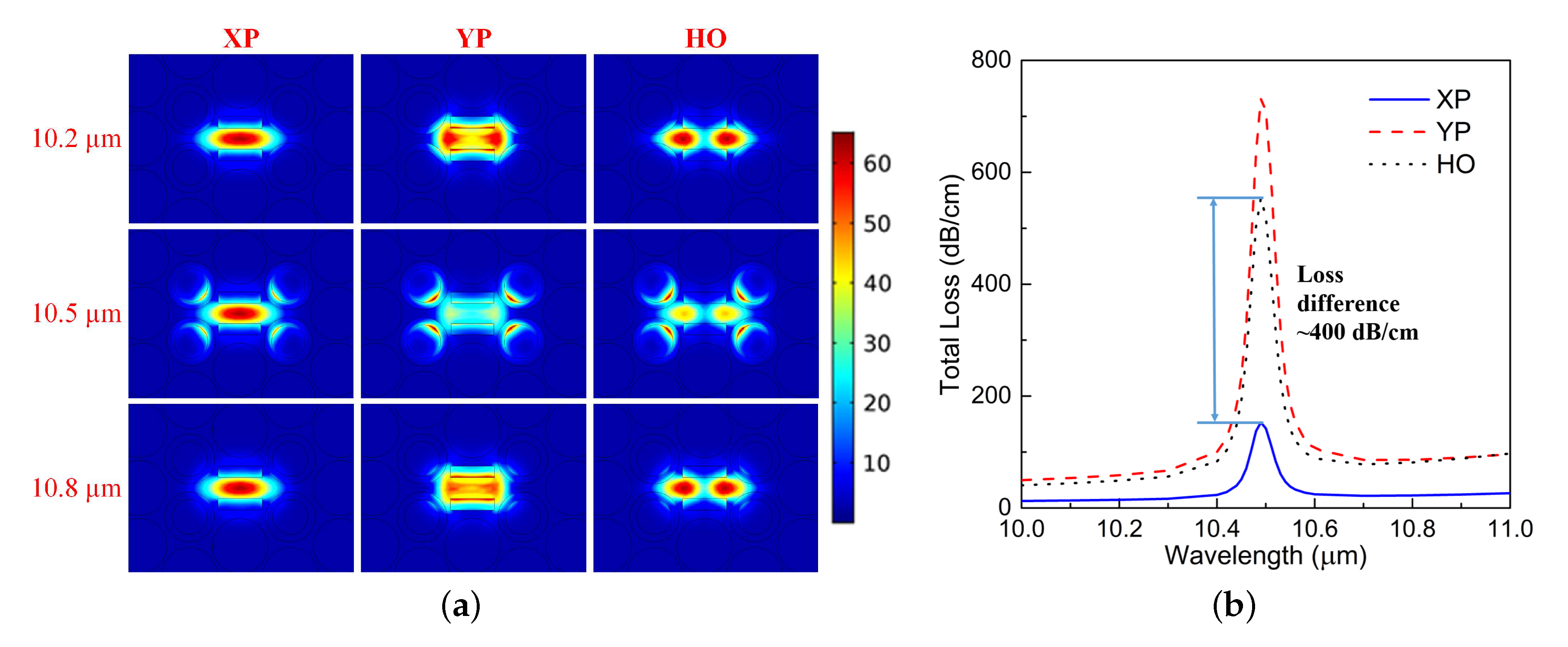

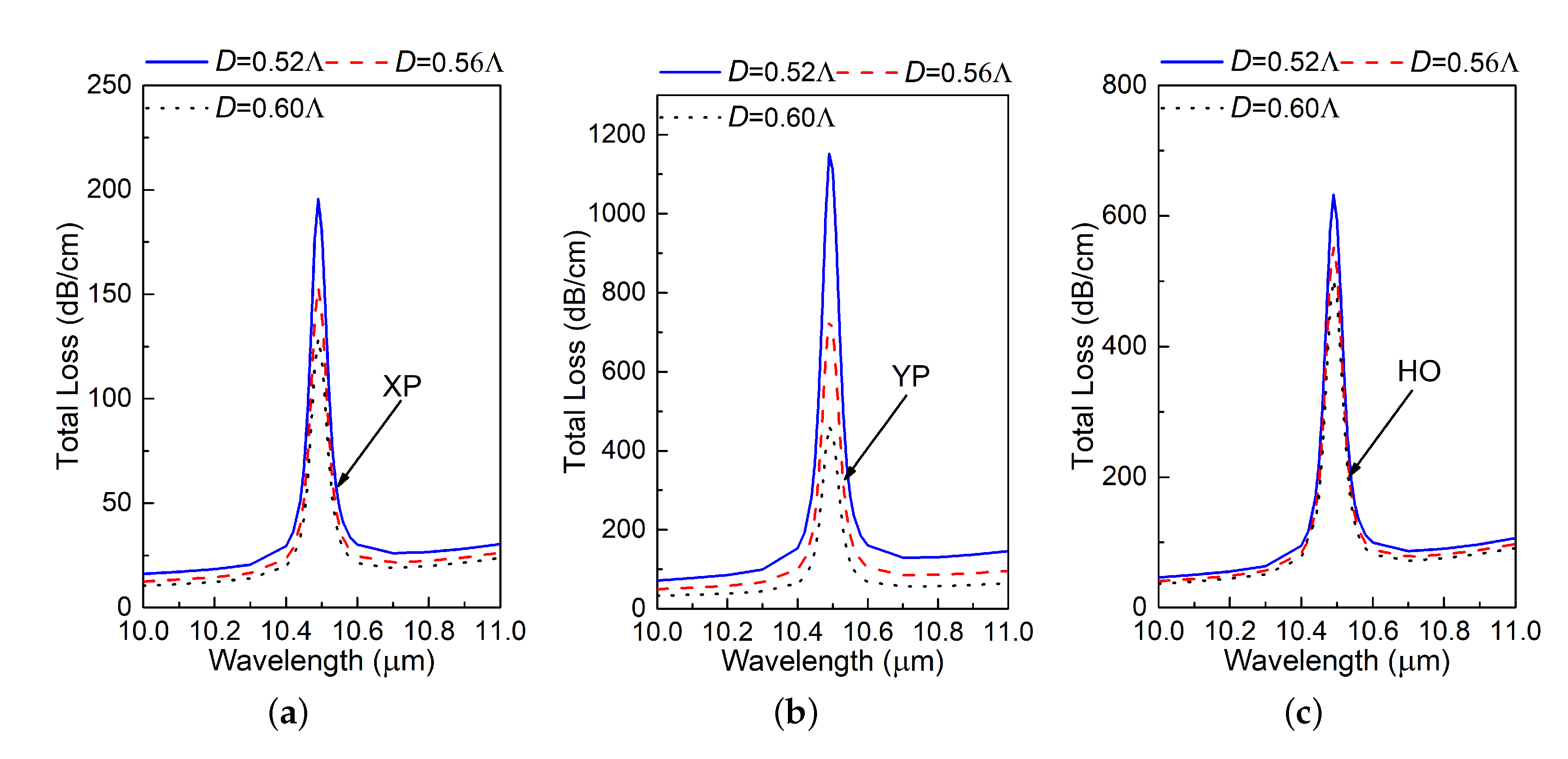


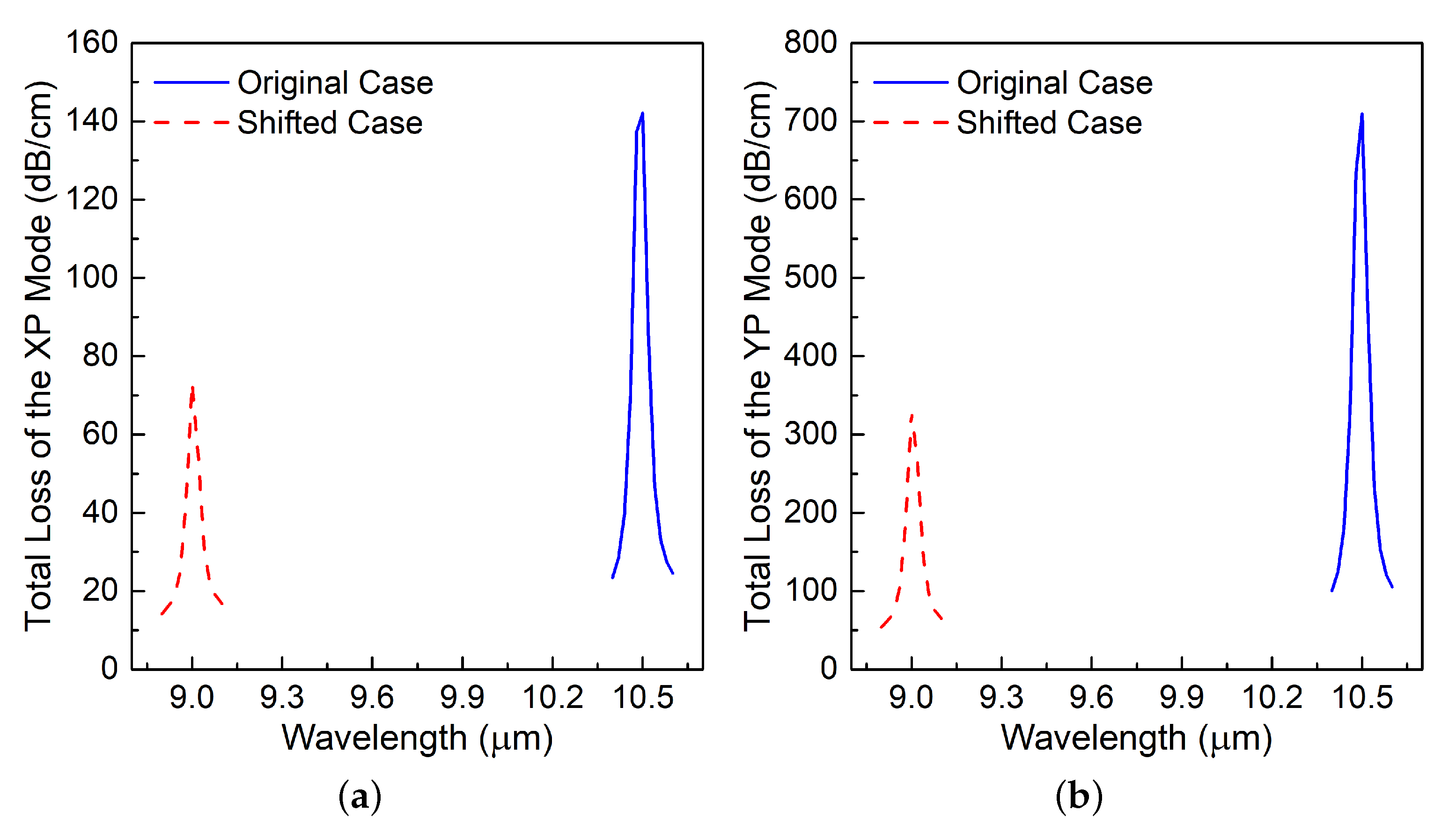
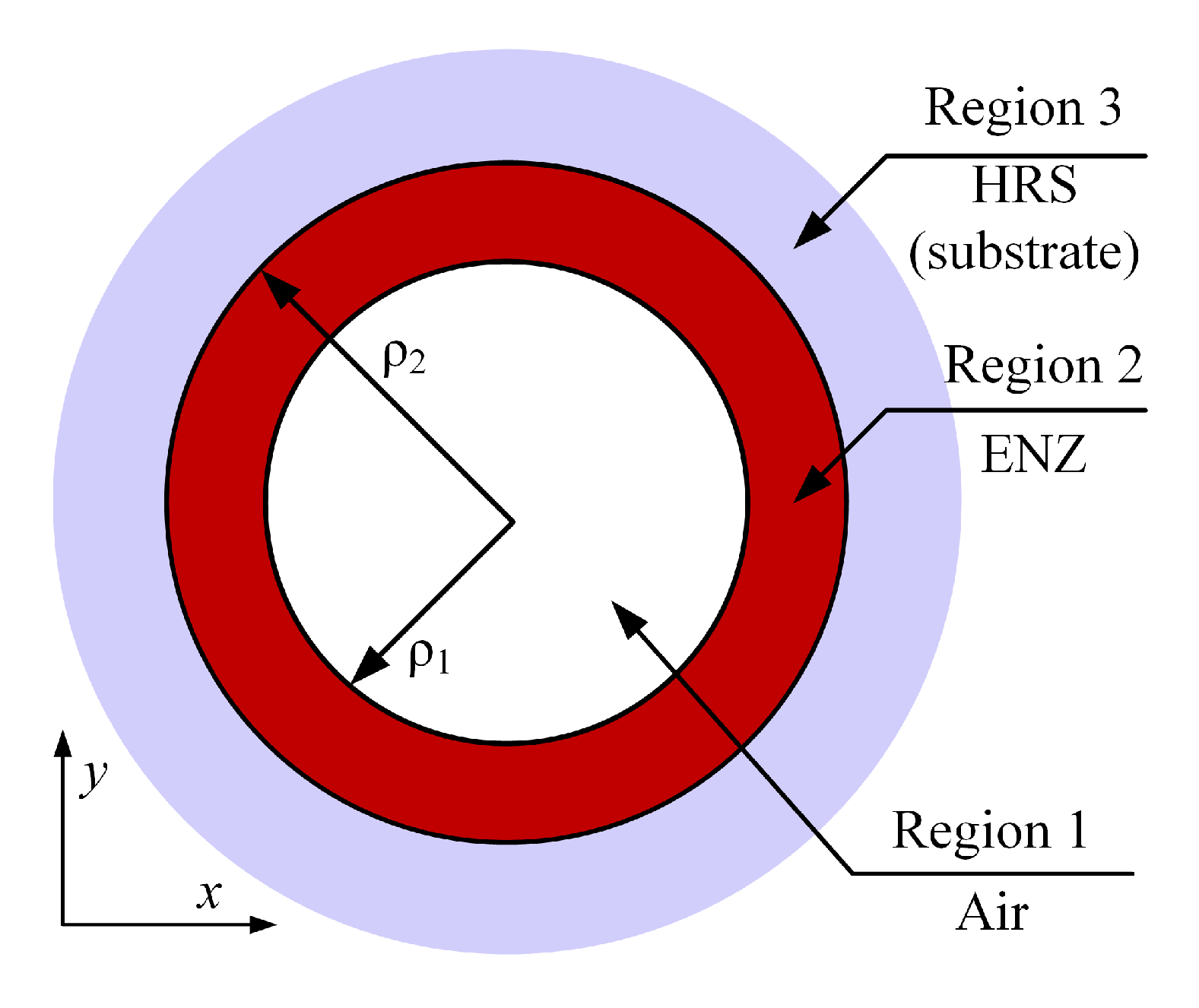
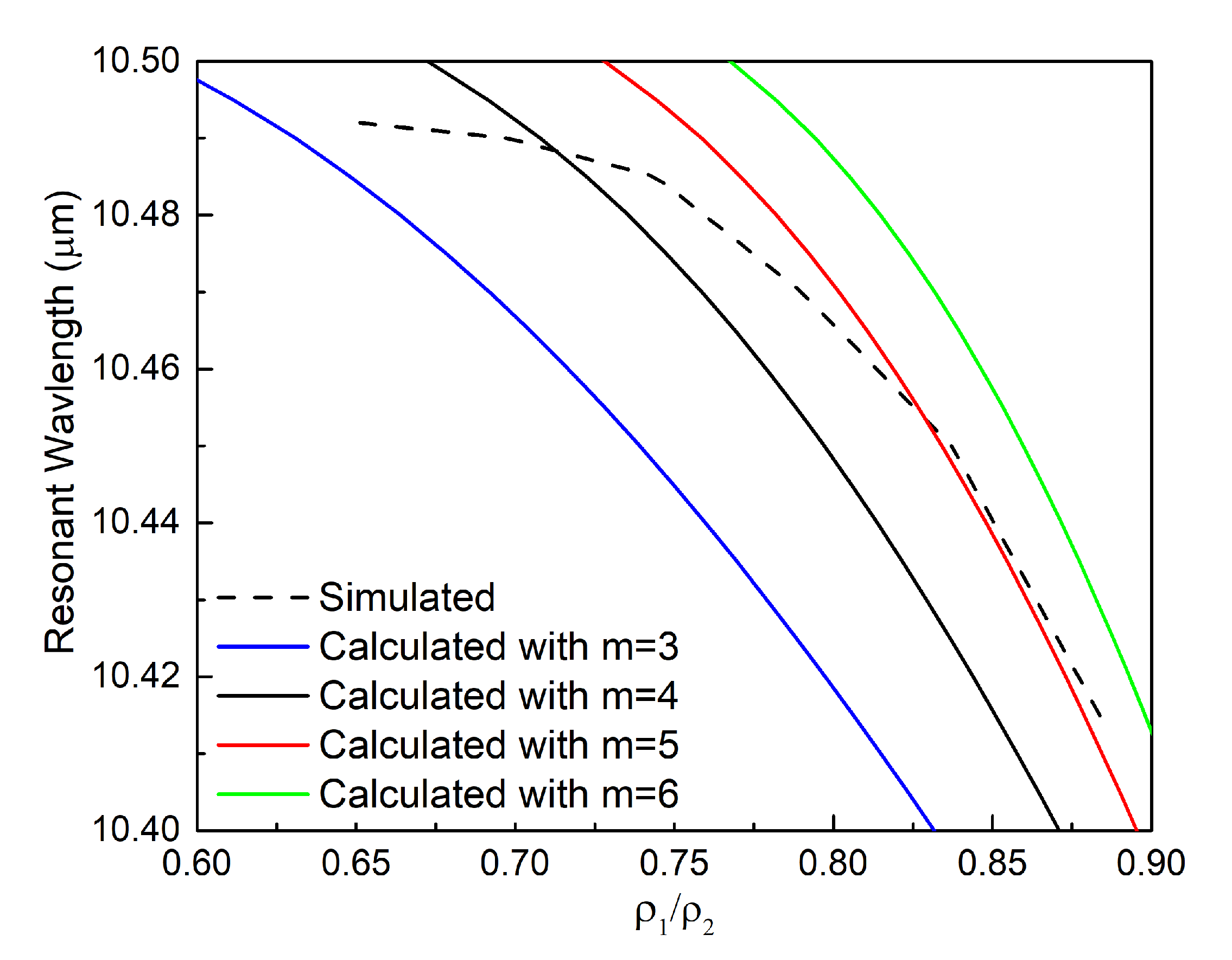

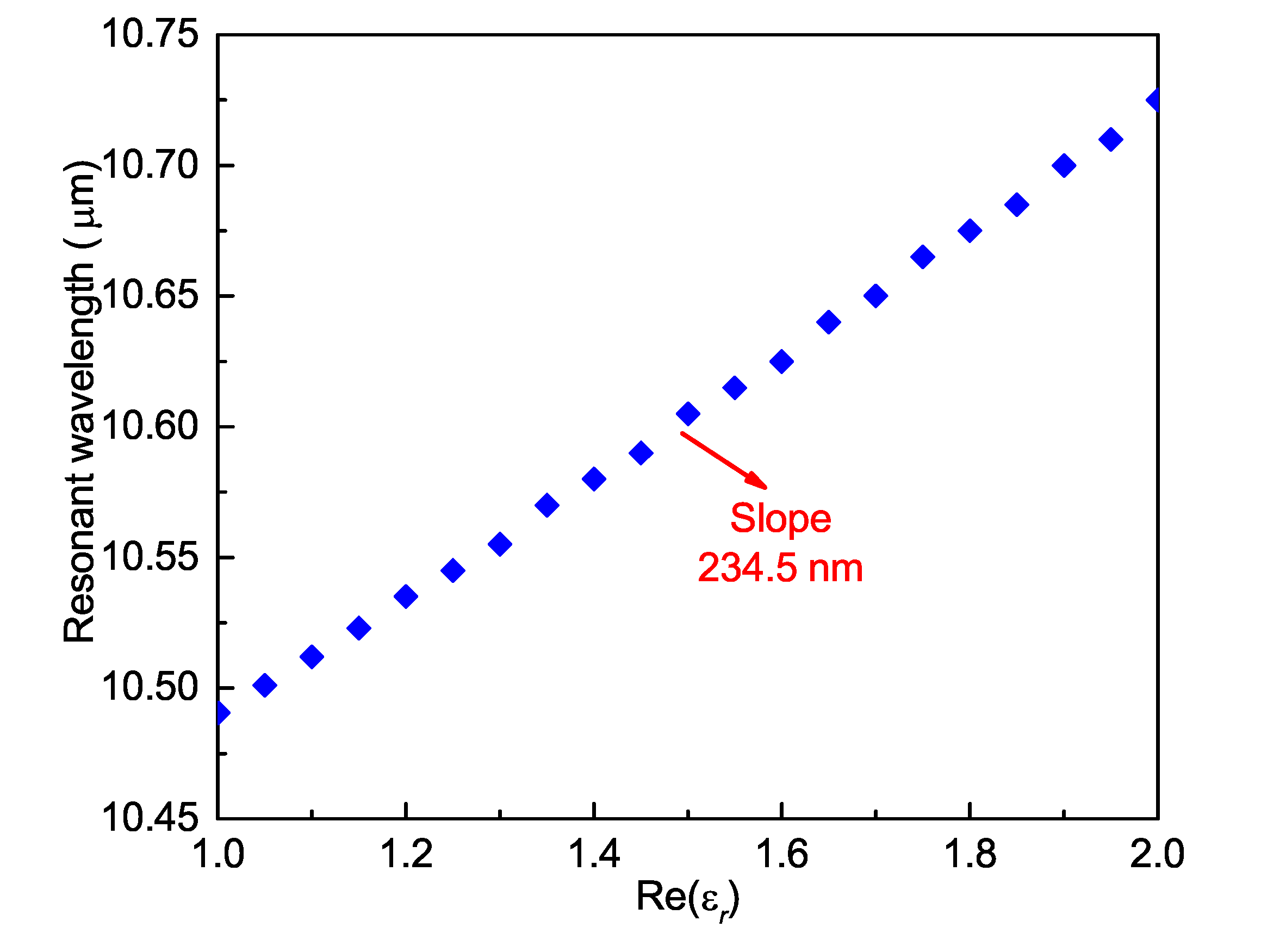
| Resonance Mode Number (m) | 1 | 2 | 3 | 4 | 5 | 6 | |
|---|---|---|---|---|---|---|---|
| Solution 1 | −0.31 | −0.56 | −0.75 | −0.87 | −0.93 | −0.97 | |
| (m) | 10.37 | 10.43 | 10.47 | 10.49 | 10.512 | 10.516 | |
| Solution 2 | −22.17 | −12.01 | −9.03 | −7.82 | −7.26 | −7.00 | |
| (m) | 11.30 | 11.32 | 11.36 | 11.44 | 11.60 | 11.92 | |
| 0]* Reference | Sensitivity | 0]* Sensitivity per Linewidth | Detection Range |
|---|---|---|---|
| (nm/RIU) | (Refractive Index) | ||
| [42] | 252 | 83 | 1.33–1.38 |
| [43] | 260.8 | 33 | 1.333–1.373 |
| [44] | 199 | 19 | 1.336–1.371 |
| [45] | 286.2 | 14 | 1.33–1.39 |
| [46] | 428.1 | - | 1.317–1.445 |
| [47] | 510 | 320 | 1.59–1.61 |
| [48] | 596 | 7.5 | 1.00–1.05 |
| [49] | 500 | 4.5 | 1.00–1.30 |
| [50] | 8028 | 4.0 | 1.00–1.20 |
| This work | 566.6 | 35.4 | 0.77–1.41 |
© 2020 by the authors. Licensee MDPI, Basel, Switzerland. This article is an open access article distributed under the terms and conditions of the Creative Commons Attribution (CC BY) license (http://creativecommons.org/licenses/by/4.0/).
Share and Cite
Yang, T.; Ding, C.; Ziolkowski, R.W.; Guo, Y.J. A Controllable Plasmonic Resonance in a SiC-Loaded Single-Polarization Single-Mode Photonic Crystal Fiber Enables Its Application as a Compact LWIR Environmental Sensor. Materials 2020, 13, 3915. https://doi.org/10.3390/ma13183915
Yang T, Ding C, Ziolkowski RW, Guo YJ. A Controllable Plasmonic Resonance in a SiC-Loaded Single-Polarization Single-Mode Photonic Crystal Fiber Enables Its Application as a Compact LWIR Environmental Sensor. Materials. 2020; 13(18):3915. https://doi.org/10.3390/ma13183915
Chicago/Turabian StyleYang, Tianyu, Can Ding, Richard W. Ziolkowski, and Y. Jay Guo. 2020. "A Controllable Plasmonic Resonance in a SiC-Loaded Single-Polarization Single-Mode Photonic Crystal Fiber Enables Its Application as a Compact LWIR Environmental Sensor" Materials 13, no. 18: 3915. https://doi.org/10.3390/ma13183915
APA StyleYang, T., Ding, C., Ziolkowski, R. W., & Guo, Y. J. (2020). A Controllable Plasmonic Resonance in a SiC-Loaded Single-Polarization Single-Mode Photonic Crystal Fiber Enables Its Application as a Compact LWIR Environmental Sensor. Materials, 13(18), 3915. https://doi.org/10.3390/ma13183915






